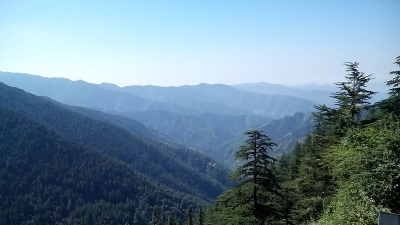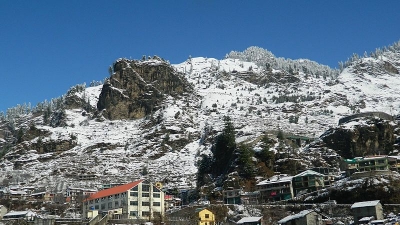Kullu Attractions - Tourist Places To Visit In Kullu
-
01Raghunath Temple
+ Read MoreRaghunath Temple is a prominent religious site located in Sultanpur, Kullu, Himachal Pradesh, is devoted to the Hindu deity- Raghunath Ji. A unique blend of Pyramidal as well as Himachali styles of architecture, the temple presents the architectural style of mid-17th century. the temple was built by Raja Jagat Singh of Kullu.
The idol enshrined in the temple is said to have been taken from the Tretnath Temple of Ayodhya, Uttar Pradesh. According local belief, this idol was once used by Rama (the seventh avatar of the Hindu god of preservation, Vishnu) during the Ashwamegh Yagya.
-
02Jagannathi Devi Temple
 + Read More
+ Read MoreJagannathi Devi Temple, dedicated to Bhubaneswar, the sister of the Hindu god of preservation, Vishnu, is a renowned pilgrimage site at Bekhli, Kullu. According to local belief, the Jagannathi Devi Temple was built around 1500 years ago. The temple lies at an altitude of 1800 m above sea level and can be reached after a 90-minute trek to the top.
The walls of the Jagannathi Devi Temple are embellished with images of Goddess Durga, the embodiment of feminine force in the Hindu religion. The idol enshrined in the temple showcases the Gaddi and Rajasthani tribal style of craftsmanship. A popular folklore narrates the story of a shepherd boy who discovered two girls dancing to the tune of his magical flute. According to the tale, the boy caught hold of one of the girls who revealed her true identity as a goddess. Ever since, the goddess decided to reside in the village of Bekhli.
-
03Sultanpur Palace
 + Read More
+ Read MoreSultanpur Palace, popularly known as the Rupi Palace, is a magnificent palace located in the Kullu. The original structure was destroyed in a major earthquake that hit India in 1905 after which it was reconstructed to its original form. Several miniature paintings done in Kullu style can be seen at the palace.
The palace is quite popular for its architecture, which is a combination of Pahari, a broad generalisation of groups of people living in the Himalayan foothills towards the north of India, and colonial architectural styles. Massive wooden logs were used to build the entry to the palace. The palace is currently occupied by the members of the ruling family, because of which tourists have to seek permission from them before entering the place.
-
04Bijli Mahadev Temple
+ Read MoreBijli Mahadev Temple, situated along the banks of the Beas river, is a popular pilgrimage site of Kullu located in proximity to Manali. Dedicated to Shiva, the Hindu god of destruction, this site is located at an elevation of 2450 m above sea level.
This temple represents the Pahari, a broad generalisation of groups of people living in the Himalayan foothills towards the north of India, architectural style and is renowned for its 60 ft tall staff. According to local belief, the ‘Shiva lingam’, the idol symbolising Shiva, inside the shrine had broken into pieces because of lightening. Later, the priests of the temple joined the shattered ‘Shiva lingam’ with butter.
This ceremony of joining the parts of the Shivlinga takes place annually. Tourists planning to visit this temple have to climb an uphill path that is flanked by pine trees. The beautiful views of the Parvati as well as the Kullu valleys can be seen from the temple.
-
05Chandrakhani Pass
 + Read More
+ Read MoreChandrakhani Pass positioned 3600 m above sea level lies in the valley of Parbati which is connected with the valleys of Malana and Kullu. Popular for its natural beauty, this pass serves as a perfect trekking base. A small hamlet known as Malana, where trekkers can halt, is located just below this pass. The months between May and October are considered ideal for trekking through this pass.
-
06Basheshwar Mahadev Temple
 + Read More
+ Read MoreBasheshwar Mahadev Temple is located in the village of Bajura of the Kullu district on the National Highway 21 at a distance of 15 km from the town. The temple, situated on the banks of river Beas, is known for its stone carvings, sculptures and shikharas or towers which are flat topped.
The temple enshrines a large idol of the Yoni Lingam which represents Shiva, the Hindu god of destruction, and his consort, Goddess Parvati. Floriated scrollwork decorate the exterior of the temple while intricate stone carvings the inside. Small shrines of Vishnu, the Hindu god of preservation, Lakshmi, the Hindu goddess of wealth and prosperity, Durga, the embodiment of feminine force in the Hindu religion, and Ganesha, the Hindu elephant-god, can be seen outside the temple.
-
07The Great Himalayan National Park
 + Read More
+ Read MoreThe Great Himalayan National Park, otherwise known as Jawahar Lal Nehru Great Himalayan Park, is one of the prominent tourist attractions of Kullu. Sprawled over an area of 50 sq km, the national park is home to a wide variety of flora and fauna including over 30 species of mammals and more than 300 species of birds.
It is especially known for the western tragopans, highly endangered species of birds, which live in the forests of this park. The park, along with Kanawar Wildlife Sanctuary, Rupi Bhaba Sanctuary and Pin Valley National Park, make up one of the largest regions of ecosystems of the Western Himalayan region in North India that are relatively undisturbed.
Animals such as brown bears, ibex, black bears, musk deer, rare species of snow leopard and the Himalayan thar can be spotted here. The vegetation of this park includes a canopy forest, an oak forest, alpine scrubs, sub-alpine communities and alpine meadows. Berberis, Indigofera, Sarcococca and Viburnum are other species of the vegetation seen in the area. The park is also home to numerous herbaceous species that can be utilised for their aromatic and medicinal properties.
-
08Hanogi Mata Temple
 + Read More
+ Read MoreHanogi Mata Temple is a famous religious centre of Kullu that lies on the Mandi-Manali National Highway. The temple is dedicated to the Hindu Goddess Hango Mata and devotees visit here all through the year. The location of this temple is quite picturesque as it is positioned on the top of a small peak and is surrounded with green mountains.
-
09Pin Valley National Park
 + Read More
+ Read MorePin Valley National Park situated in the valley of Spiti is the only national park in the state of Himachal Pradesh, which is positioned in a cold desert area. Sprawled over an area of 675 sq km, this park was founded in 1987. The park is home to around 20 species of animals and birds and is known for protecting the endangered snow leopard. Some of the animals commonly found here include the pika, bharal, chukor, weasel, golden eagle, ibex, Himalayan chough, marten, red fox, snow cock, griffon, bearded vulture and raven.
The flora of the Pin Valley consist of around 400 plants species along with herbs and spices. Herbs found here have rich medicinal properties which can be used for preparing medicines. Travellers will have to get permission of the director of the Pin Valley Park to enter this park.
-
10Deo Tibba
 + Read More
+ Read MoreDeo Tibba, located to the south-east of Manali, at an altitude of 6001 m, is popular amongst tourists as a base for trekking. While undertaking a trek to Deo Tibba, travellers will come across the Jagatsukh village situated 5 km from Manali. From there, the travellers need to walk to Khanol that lies at an altitude of 2200 m.
-
11Gaurishankar Temple
 + Read More
+ Read MoreGaurishankar Temple is a renowned religious site of the destination, which is situated in Naggar. This temple was constructed between the 11th and 12th centuries. Dedicated to Lord Shiva, Gauri Shankar Temple is believed to be the last monument built in the Gurjara-Pratihara traditions.The main attractions of the temple are its stone carvings and the front of the garbhagriha, or small unlit shrine, which features carvings of the figures of the Hindu elephant-god, Ganesh, flowers, a musician and a dancer. The temple is built like a pyramid on an elevated platform with a square shape at the base and dome shape on the top.
-
12Kaisdhar
 + Read More
+ Read MoreKaisdhar, located on the lush highland of Khajjiar, is a popular picnic spot situated 15 km from Kullu. Encircled by deodar trees, the meadow is picturesque and ideal for spending some leisurely time.
-
14Sujanpur Fort
 + Read More
+ Read MoreSujanpur Fort, built in 1758 by the emperor of Kangra, King Abhaya Chand, is one of the beautiful buildings located in the town of Hamirpur in Sujanpur. The fort is also popular for its many paintings. During the early 19th century, the king of Kangra, Sansar Chand, a follower of the Pahari School of Miniature Paintings, lived here. When the emperor lost Kangra to the British, Sujanpur Fort became a shelter for him and his family. There are 12 chambers and a hall in the building of this fort.
The chambers here were made for the other kings who would come to meet with King Sansar Chand in Kangra. Situated on the banks of Beas river, the fort also has a Barahdari Hall where hearings were held. The large compound of this fort is now used for Holi celebrations, a popular Hindu festival of colours which is celebrated for 3 to 4 days. Some other popular spots here are the temples of Narvadeshwar, Gaurishankar and Murli Manohar.
-
15Trekking
+ Read MoreTrekking is one of the popular adventure sports in Kullu. The region serves as a major trekking base in the state of Himachal Pradesh. Although numerous popular treks are available here, a maximum of the trails are located ahead of the Rohtang Pass situated in the valleys of Zanskar, Ladakh, Lahaul and Spiti. Tours of 10-12 days are organised in the region from Pin Parbati Pass to the valley of Spiti and from Manikaran to Chhota Dhara.
Generally the treks organised here pas through remote areas and take two to three weeks to complete. Trekkers pass by numerous ancient temples located on the way. The period between April and mid-June and mid-September and mid-October, are considered as ideal for trekking here.



 Click it and Unblock the Notifications
Click it and Unblock the Notifications









